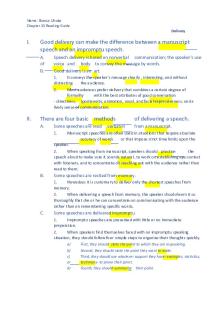Chapter 13 Study Guide PDF

| Title | Chapter 13 Study Guide |
|---|---|
| Author | Kaleb Madsen |
| Course | Principles of Evolution |
| Institution | Utah Valley University |
| Pages | 1 |
| File Size | 74.7 KB |
| File Type | |
| Total Downloads | 87 |
| Total Views | 149 |
Summary
Study Guides for Evolution 4500...
Description
BIOL 4500-001 Chapter 13 Study Guide You should be able to fully and consistently do the following from Chapter 13, the lecture videos and slides, your reading/writing assignments, and the supplemental reading and slides on polyploidy for this chapter, including the ability to fully define and apply a working understanding of the boldfaced terms:
Make sure that, in addition to reading the chapter, you read the supplemental reading on polyploidy, and study the slides and lecture video on this topic, disregarding the information on pages 437 and 438 of your textbook. Compare the biological species concept, the phylogenetic species concept, and the general lineage species concept with one another, and explain why it has been difficult, both historically and currently, to define the term species. Distinguish between pre-zygotic and post-zygotic reproductive isolating mechanisms, and provides some examples. Define allopatry and how geographic barriers are related to this form of speciation. Define genetic incompatibility and explain why this is especially important in plants that produce pollen. Explain how epistatic interactions provide post-zygotic reproductive isolation, in accordance with Bateson-Dobzhansky-Muller incompatibilities. Describe how two prezygotic barriers to reproduction evolved in sweet vernal grass, and why natural selection would favor one in response to the other. From Table 13.7 on page 423, identify the names of the two types of isolation that evolved in this species (from the second and third rows in the table). Also, define reinforcement, and explain how that is a key factor in this example. Using diagrams of paired chromosomes in meiosis, explain why chromosomal rearrangements, specifically inversions and translocations, are post-zygotic barriers to reproduction (see the lecture video and lecture slides for this topic because it is insufficienty addressed in your textbook). As an example, explain how the human and chimpanzee genomes differ in terms of chromosomal rearrangements, and identify which rearrangements in these two genomes ancestral in one species and derived in the other. Compare allopatric, sympatric, and parapatric speciation with one another, and provide examples of each. Explain how ecological speciation applies to the evolution of polar bears and brown bears. Compare autopolyploidy with allopolyploidy, distinguishing between homologous and homeologous chromosomes. Distinguish between monoploidy and haploidy, using the terms x and n. Explain how allotetraploid and allohexaploid wheat evolved from their common diploid ancestors. Define endoploidy and unreduced gametes and their roles in the evolution of polyploidy. Explain why organisms and species with odd ploidies are typically sexually infertile, whereas those with even ploidies are typically sexually fertile. Describe several different scenarios by which an allopolyploid species may arise through endoploidy and unreduced gametes. Explain what a cryptic species is and how DNA analysis has facilitated the identification of cryptic species. Explain why the species concepts for eukaryotes are less applicable to prokaryotes, and how prokaryotic evolution proceeds in contrast to eukaryotic evolution.
From your textbook, answer the following end-of-chapter questions (pages 446–447): Multiple-choice questions 2, 3, 4, 6, 8, and 10. Short-answer questions 1, 2, 3, 4, 5, 6, and 7. You can check your answers against those given by the textbook authors on page 682....
Similar Free PDFs

Chapter 13 - Study Guide
- 22 Pages

Chapter 13-study guide
- 24 Pages

Chapter 13 study guide
- 6 Pages

Study Guide Chapter 13
- 17 Pages

Chapter 13 Study Guide
- 1 Pages

Chapter 10-13 study guide
- 15 Pages

Chapter 13 study guide-Palmtag
- 4 Pages

Oblicon Study Guide (13)
- 3 Pages

Exam 2 Chapter 13 Study Guide
- 8 Pages

Chapter 13 Reading Guide
- 4 Pages

Hobbes Leviathan 13 study guide
- 2 Pages

Chapter 5 Study Guide
- 5 Pages

Chapter 14 study guide
- 7 Pages

Chapter 4 Study Guide
- 4 Pages
Popular Institutions
- Tinajero National High School - Annex
- Politeknik Caltex Riau
- Yokohama City University
- SGT University
- University of Al-Qadisiyah
- Divine Word College of Vigan
- Techniek College Rotterdam
- Universidade de Santiago
- Universiti Teknologi MARA Cawangan Johor Kampus Pasir Gudang
- Poltekkes Kemenkes Yogyakarta
- Baguio City National High School
- Colegio san marcos
- preparatoria uno
- Centro de Bachillerato Tecnológico Industrial y de Servicios No. 107
- Dalian Maritime University
- Quang Trung Secondary School
- Colegio Tecnológico en Informática
- Corporación Regional de Educación Superior
- Grupo CEDVA
- Dar Al Uloom University
- Centro de Estudios Preuniversitarios de la Universidad Nacional de Ingeniería
- 上智大学
- Aakash International School, Nuna Majara
- San Felipe Neri Catholic School
- Kang Chiao International School - New Taipei City
- Misamis Occidental National High School
- Institución Educativa Escuela Normal Juan Ladrilleros
- Kolehiyo ng Pantukan
- Batanes State College
- Instituto Continental
- Sekolah Menengah Kejuruan Kesehatan Kaltara (Tarakan)
- Colegio de La Inmaculada Concepcion - Cebu

